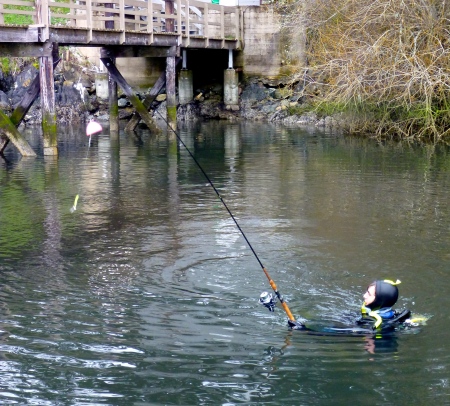First year marine scientists travelled to East Sooke Park during block week (D block on 5 March and B block on 6 March) where they explored the intertidal zone. We saw many amazing creatures and seaweeds, including:

Spawning Nucella lamellosa with an interloping N. canaliculata on the far right.

More spawning Nucella lamellosa

Lacuna egg masses

The dwarf mottled blood star, Henricia pumila & eggs (the bright orange goo to the right of the black leather chiton, Katharina tunicata). I have not seen these eggs before and was very interested to learn that this species has only recently been described (2010) and it broods its eggs, unlike other Henricia species which are broadcast spawners.

Amit with another species of Henricia.

This nemertean Cerebratulus californiensis was crawling on the sandy beach when Alba spotted it. Alba certainly has an eye for worms – she also spotted the nereid worm pictured below.

The worm (Nereis vexillosa) did show off its big black jaws (but not in this photo unfortunately).

Lucas found this striped sun star, Solaster stimpsoni, which did have a commensal worm…

Solaster stimpsoni and its commensal scale worm, Arctonoe vittata (seen to the right of sea star’s mouth).

Kiera found a pair of six armed stars (Leptasterias hexactis).

And Griffin found a sea leopard, Dialula sandiegensis.

The sea leopard, Dialula sandiegensis.

The brooding anemone, Epiactis prolifera, one with no offspring and the other (on the right) with many offspring!

A well camouflaged decorator crab…

…not so well camouflaged on Marc’s hand.

Mastocarpus sp. and Ulva lactuca.

Periwinkles (Littorina sitkana) in the crack of a boulder


Students had a wonderful time on Wednesday, despite the wet weather!

It only drizzled on Tuesday, but Steph still managed to get quite wet – she filled her boots!
Here is a fairly complete species list from the two days at East Sooke Park:
Haliclona sp., Halichondria panicea, Ophlitospongia pennata
Anthopleura elegantissima, Urticina crassicornis, and other Urticina spp.
Cerbratulus californienesis
Eudistylia vancouveri, Nereis vexillosa
Mopalia muscosa, Katharina tunicata, Mytilus californiensis, Diadora aspera (with commensal worm), Littorina sitkana, Nucella ostrina, Nucella lamellosa, Nucella canaliculata, Archidoris montereyensis, Dialula sandiegensis (and egg mass)
Pollicipes polymerus, Balanus glandula, Semibalanus cariosus, Chthamalus dalli, Idotea wosnesenskii, Hemigrapsus nudus, Hemigrapsus oregonensis, Petrolisthes sp., Decorator crab, Pagurus hirsutiusculus, Pugettia producta, Cancer productus (juvenile), Cancer oregonensis
Pycnopodia helianthoides, Pisaster ochraceus, Evasterias troschelii, Henricia pumila (with eggs), and other Henricia spp., Lepasterias hexactis
Oligocottus maculosus, Gobiesox meandricus, Gunnels (one guarding eggs)
Ulva lactuca, Enteromorpha intestinalis, Acrosiphonia coalita, Codium fragile
Hedophyllum sessile, Fucus gardeneri, Nereocystis luetkeana, Macrocystis integrifolia (drift)
Mazaella sp., Corallina vancouverensis, Bossiella sp., Lithothamnion sp., Odonthalia floccosa, Endocladia muricata, Prionitis lanceolata











































